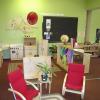- Distinguish between spaces for group activities, privacy, storage, and display.
- List ways to make environments feel homelike, and identify possible provocations.
- Describe how to organize materials for independence, easy use, and learning.
- Design engaging and well-organized indoor environments for school-age children and youth.
Learn
Know
We now know that environments send us powerful messages. A carefully planned environment can help school-age children feel calm and secure, while at the same time, engaged and inquisitive. Within the first lesson, we introduced general ideas to consider when designing environments for school-agers and key activity areas that foster child and youth learning. However, when designing or redesigning your indoor space, it is also important to consider logistics, aesthetics, organization, and the needs of all children in the space.
A program’s indoor space should meet the needs of children and youth and allow them to explore their interests and take initiative. These settings should (Council on Accreditation, 2018):
- Be well arranged for a variety of activities.
- Have adequate storage for personal items of children, youth, and staff.
- Have developmentally appropriate materials in well-organized places that allow children and youth to take materials out and return them by themselves.
- Have appropriately sized furniture that children and youth can use comfortably.
- Display children’s artwork, family photos, or other décor that makes the space feel personalized and home-like.
- Have an area with soft seating for children and youth to rest or be alone.
In addition, these environments should be safe and healthy. Maintaining a safe and healthy indoor learning environment is aided by completing your program’s safety checklists, ensuring that all materials and equipment are in working order, and maintaining expectations that keep children and youth free from harm. When designing your space, make sure that you can supervise all areas, including private spaces. Refer to the Safe Environments and Healthy Environments courses for more information.
Designing for Logistics
In your school-age environment, you will need spaces for group activities, privacy, storage, and display. It is also important to think about setting up your classroom with emergent inquiry in mind. Emergent inquiry can be described as learning that evolves as the interests of the children change and they make new discoveries about the world around them. This can include learning centers with flexible spaces, open-ended materials, and a daily schedule.
Places for Group Activities
Children and youth likely spend much of their formal school day with little choice in how they spend their time, so they often look to their “after-school” or “summer camp” environments to provide more autonomy. Indeed, free play is important for children’s development and should be a significant part of school-age programs. However, this does not mean your program should lack structure or that providing more structured activities is inappropriate, especially if children have a choice in the experiences they select. Participation in engaging, yet structured, school-age programs has been linked to children’s positive academic outcomes and greater motivation for learning (Mahoney, Lord & Carryl, 2005).
To support structured activities, you should plan areas that support group meetings. Depending on the size of your school-age program, whole-group meetings may be relatively rare or even impossible, however, you will want some spaces that support smaller group meetings where you can bring a few children together to help build relationships and teach skills or concepts particular to the interests they are exploring. Children can even be presenters during this time, sharing a new technique, relevant research, or book they found. Having designated spaces for these activities and designing them to minimize distractions can help you make the most of these times. This does not mean you have to have a spot that is used just for group activities. In some smaller environments, this simply is not possible. Staff members can get creative and be flexible with these ideas! Atypical meeting spaces can be adjusted by using sheets, turning shelves around or adding stop signs to minimize distractions and support engagement. Just make sure there is enough space for everybody involved to sit comfortably. Space is very important and can enhance or hinder a child’s learning. For example, too much or too little space may make a child feel overstimulated or frustrated and could cause unwanted behaviors (Kaiser, B. & Rasminsky, J., 2020).
Places for Privacy
School-age programs are high-energy places. As with adults, children need time and space during the day to relax on their own. Especially after being in formal school, school-age children may crave some down time. It is important to provide a calming space to take a break from the group. This space can be limited to one or two children and created so that there is still visibility to ensure safety.
Places for Storage and Display
School-age programs require a lot of materials! Toys, books, games, and other resources are regularly rotated in and out of active use. It is important to plan for at least three kinds of storage in your school-age program: open storage that children and youth can easily access, closed storage for teacher materials, and storage for personal belongings (Dodge et al., 2016). It is also important to plan for storage and display of children’s assessment materials and artwork.
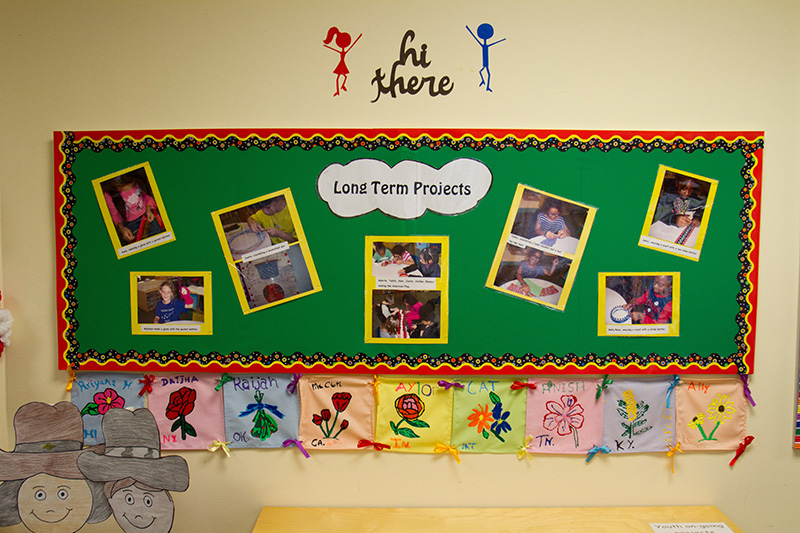
Aesthetics
In Lesson One, we discovered that high-quality, school-age programs send numerous positive messages to children and youth. One of the best ways you can communicate with school-age children that your program is “a good place to be” is through the small touches you place throughout the environment that express the personality of your program. Educators Jane Tingle Broderick and Seong Bock Hong suggest you “practice working with the concept of aesthetics in your classroom by focusing on your use of visual cues and the organization of materials” (2020, p. 11).
Homelike
Children and youth are more likely to feel that they can be themselves and have a sense of belonging when their classroom environment feels like their homes. “The ideal, connected approach is not to simply fill classroom spaces. Rather it is to create an environment that is meaningful to the children” write the authors of Rethinking the Classroom Landscape: Creating Environments That Connect Young Children, Families, and Communities (Duncan, S., Martin, J. & Kreth, R., 2016, p. 79). We will address this more in the Materials lesson, but there are many ways you can add personal touches to your school-age program that create a homelike feel. For example, you can include:
- Soft furniture, such as a couch or large armchair
- Nontoxic plants
- Natural or soft lighting, through the use of windows or lamps
- Throw pillows, cushions, beanbag chairs, and blankets
- Decorative touches, such as area rugs or repurposed furniture
- Family photos of the children and staff
- Inexpensive frames to hang children’s artwork on the walls
- Neutral paint colors
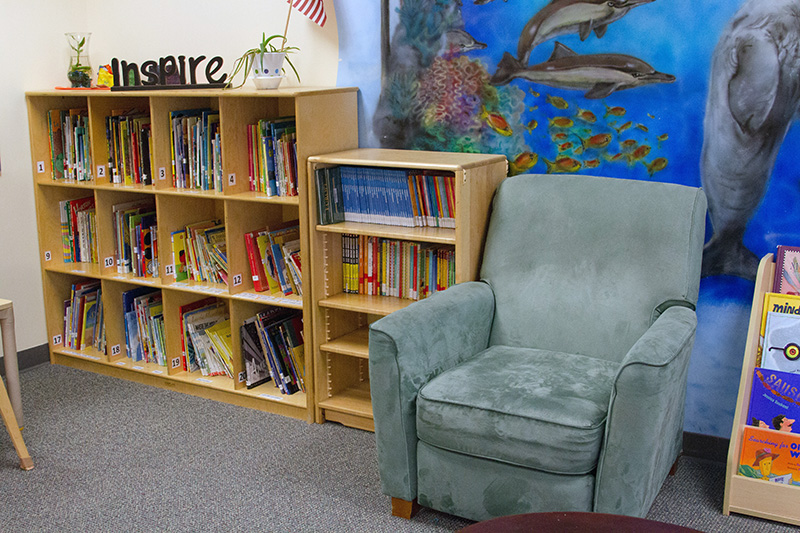
Your effort to create a relaxing, homelike environment is critical. It can be overwhelming to spend eight or twelve hours in spaces that are visually overwhelming, with bright lights or bright colors. A homelike environment, in addition to places for privacy and quiet areas, offers children and youth the opportunity to seek calm when they need it.
Including pictures of the children and their families, in conjunction with personal storage and display of children’s and youth’s artwork, is another great way to communicate that the space belongs to them. When displaying pictures or adding decorative touches, remember to hang or offer some items at children’s eye level to reinforce that they are valued members of the classroom space.
Inviting Engagement: Provocations
Offering items of beauty or wonder in your program invites children’s and youth’s exploration and engagement. One way of doing this in your program is to use provocations. A provocation is a picture, experience, or item that provokes thought, interest, questions, or creativity (Edwards, 2002). Provocations can help provoke children and youth to use or think about materials in new ways. When designing your classroom, it can be useful to think about how you will incorporate provocations. Your inspiration for what provocations to offer will often come from children’s current interests and their learning goals. “Teachers using an emergent inquiry curriculum are responsive to children, planning provocations around questions they have developed that challenge the children toward the edges of their own understandings,” (Broderick & Hong, 2020, p. 27). Provocations might include:
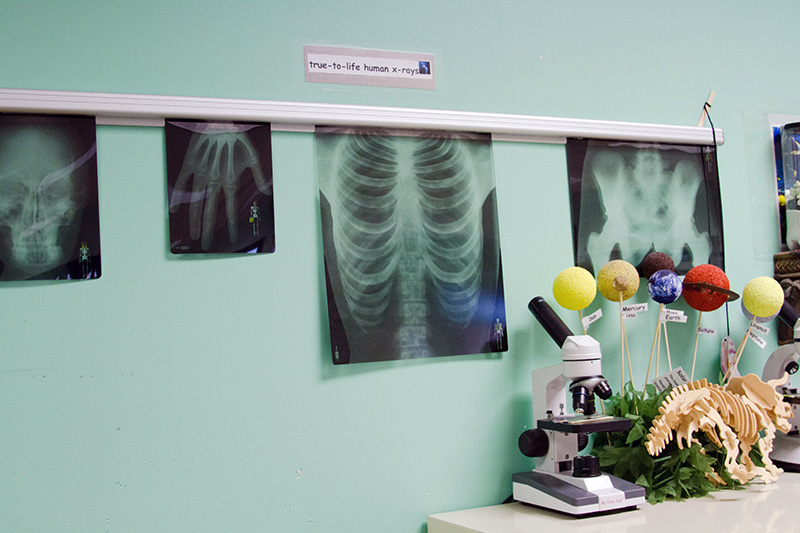
Placement is an important key to provocations. What are you hoping children will do within each activity area in your program? What concepts are you currently exploring and how might a provocation in certain areas help extend or focus children’s and youth’s play? Remember, provocations are meant to be a guide, or a point of inspiration for how children can engage with certain materials or spaces, but they are not meant to dictate what children and youth are supposed to do in each area or with the materials. Children might be inspired or provoked to create ideas that take them in other directions. “The thinking and learning that emerge from the children as they engage with provocations will reveal potential threads of inquiry,” according to Broderick and Hong (2020, p. 28). If children consistently ignore certain provocations, they may no longer be interested in that particular concept or idea.
Designing for All
When you look to design or redesign your program, you need to consider the needs and learning goals of all children. Each time a new school-age child enters your room, you should consider what changes need to be made to best support that child’s engagement in the program as well as the individual’s previous experiences. For a child with developmental disabilities, it is important to speak with the child’s family and your trainer, coach, or administrator so you know the child’s particular needs and the supports that will help. Ensuring that your classroom is welcoming to all children is critical to supporting the success of all children in your room.
In terms of environmental design, you may need to consider physical space within activity areas or pathways between activity areas to ensure that children with physical or mental disabilities can easily move around and participate. You may need to alter the physical environment with ramps, chairs, and tables that appropriately accommodate the needs and equipment for children with physical disabilities. In addition, all children, but particularly children and youth with social or behavioral needs or who have certain developmental disabilities, may benefit from a designated “calming” area where they can easily access materials that can help with self-soothing and where they can spend some time alone. To help children identify what they feel, the cool down space can also include pictures of children expressing different emotions, and pictures and words about different calming strategies (e.g., “Take deep breaths”). It can also be helpful to provide multiple visual cues for how to use spaces and materials. This could mean that within the entrance to each activity area you provide a picture of children and youth safely playing in that space, or next to the clay in the art area, you offer a small series of pictures of how children could pinch or roll the clay with their hands or use special tools.
While you are in your learning environment working with school-age children, you should observe the ways they use equipment and materials. If there is something that can be changed to better support the learning needs of any child, it should be brought to the attention of the program staff. Also see the Learn attachment that provides some adaptive equipment and materials as well as environmental supports that may be useful for some children with developmental disabilities.
Organization
Consider how you might feel if a familiar store has been completely rearranged when you walk in to make a quick purchase? Children and youth also feel frustrated when they cannot find what they need and when materials for play are unavailable. As a staff member, it is your responsibility to make sure materials are easily accessible and well organized. When organizing your materials, you should think about three goals: independence, easy use, and learning.
Organize for Independence
First, we want children and youth to know that they can find and use materials on their own. The best way to accomplish this is to store materials on open shelves at a height accessible to all school-age children in the program. This allows children to see the materials available, make a choice, and return the item without adult support. Display the toys and materials in a simple and attractive way. Keep in mind, though, that too many choices can be overwhelming.
Second, we want children to learn to use signs and symbols in the environment to support their independence. One way we help them do this is by carefully labeling objects or the places the objects belong. The best labels use written words plus pictures or parts of the object (like a puzzle piece on a puzzle box). Labeling not only helps children learn to clean up independently, but it also creates a print-rich environment, which can be especially helpful for younger school-age children who are still developing their word-recognition skills. You can also encourage them to help write the labels, giving them both a literacy and a community opportunity. As an added benefit, you may find yourself giving fewer directions and reminders. When children and youth can engage independently with materials, you have more time for interacting and expanding learning opportunities.
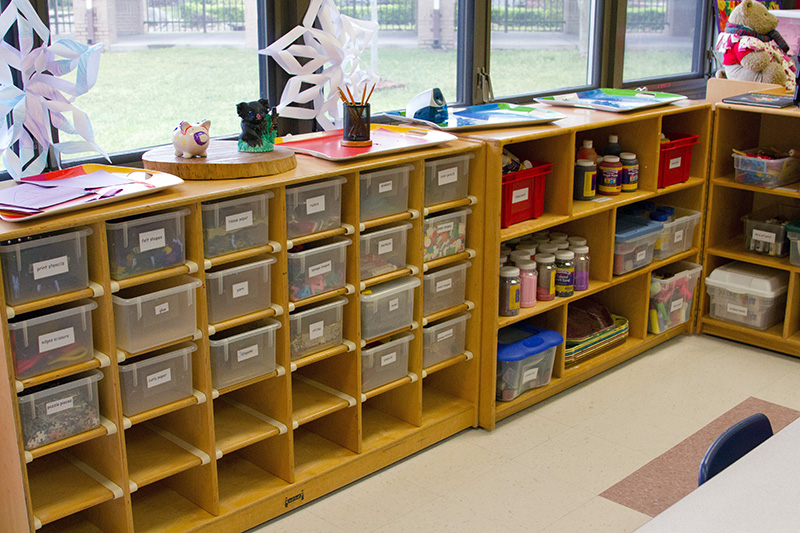
Organize for Easy Use
Materials should be organized so children want to interact with them. It is important to organize your materials so children can find what they need when they need it. This also helps children know, “I can do things on my own.” Organized materials empower children to try out ideas and use new materials. When organizing for easy use, think about storing like materials together. Like materials are things that go together or materials that are necessary for certain activities. Think like a child: If I want to work at the writing center, what will I need or want? Placing pencils, crayons, markers, paper, scissors, stickers, stencils, stamps, letter cards, word cards, name cards, and picture dictionaries all together in the writing area can allow children to get instantly involved in their ideas. This means you may have duplicate materials in many areas of the room. Pencils, paper, and clipboards are also useful in the toys and games for keeping score or developing new rules, so a set should be stored there for easy use.
The types of storage you choose, including bins, baskets, and containers, can affect how easily children access and put away materials. For example, storing books on a shelving unit that allows children to see the full front covers may spark greater interest in reading and make it easier for children to choose a book they are interested in. Storage bins should be open or have easy open-and-close lids for materials that you want children to access themselves. Bins should also be made of lightweight material (e.g., plastic instead of metal) and not too large or too heavy that children cannot handle them on their own. Clear plastic bins will allow children to easily see the materials that are inside. Bins should also be large enough to accommodate materials without tipping over. Baskets should not be made of materials that could poke or scratch children and should not be used to store materials that can fall out through the holes (e.g., crayons). The steps you take to organize for independence and easy use will also help you keep the space tidy, which can prevent safety hazards (e.g., tripping over materials). Children will know where materials belong, and they will not have to carry materials far from their storage spaces. Furthermore, these strategies help children and youth respect the materials and the classroom environment.
Organize for Learning
As discussed previously, the concept of using provocations can help you organize your space to spark or build upon children’s and youth’s interests. Displays (e.g., pictures, posters, or wall-hangings) or books can be arranged to help children and youth explore ideas or try new things with the appropriate materials nearby. Displays should be at children’s eye level and should contain their own work, pictures relevant to their interests, or pictures meant to help spark further exploration. They should reflect the backgrounds, knowledge, and experiences of the children in your program. To maintain children’s and youth’s engagement in play and learning, you will want to rotate materials regularly, so children have the chance to use different kinds of materials.
You can organize your space so children encounter meaningful learning opportunities throughout. This means providing thoughtful and well-planned literacy, math, science, and social studies materials in various activity areas. For example, offer a book about plant structure with a microscope and various natural items in the discovery and science area, or keep tape measures, clipboards, blueprints, and books about famous structures in the construction or toys and games area. The art area can include books, paintings, pottery, or other materials.
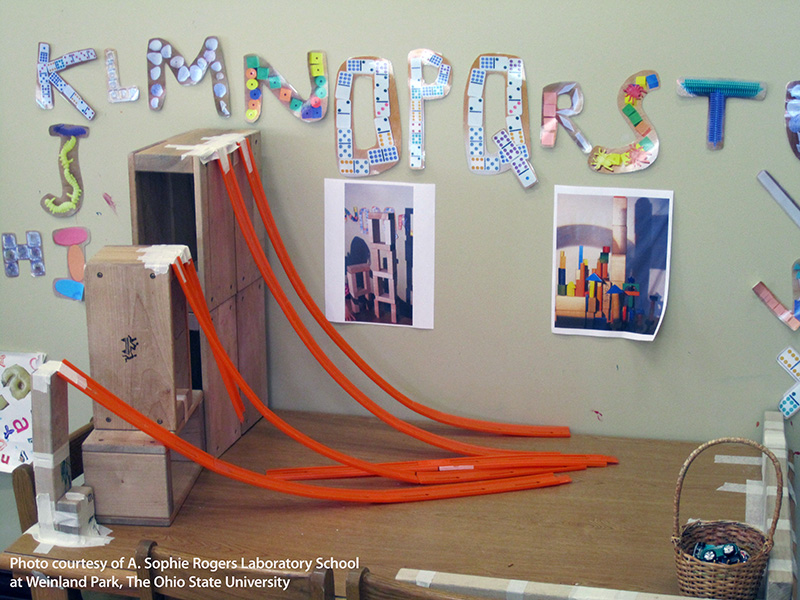
See
Think about the principles discussed in this lesson—logistics, aesthetics, organization, and attention to the needs of all children. Watch the following video and look at a few ways school-age staff members have considered these elements in their own programs.
Indoor Environments
Do
Indoor arrangement of the physical environment is an art and a science. It is an art for you to make your program feel welcoming and like a home. It is a science as you use knowledge of developmentally appropriate practice to design your program’s floor plan.
- Make the indoor environment feel like home. Use some of the suggestions within this lesson to make your classroom feel comfortable yet engaging including neutral colors, soft furniture, and framed art.
- Consider the needs of all children. Recognize that children and youth spend a lot of time in your program, and everybody needs a break sometimes. Provide a variety of ways that children can take a little time for themselves; a quiet book area, a computer center, or the art area can all provide a brief break from the busy, social day. This can be especially important to some children with special needs.
- Plan ahead. Think about how you will use spaces for group activities, storage, and display. Then identify the resources you need to make those spaces work for you. Make a list of all the materials you will need in each space based on the activities, storage, and displays that you are planning.
- Keep safety a priority. When designing your space, make sure that you can supervise all areas, including private spaces. Make sure that you have secure storage for all items that are unsafe for children (e.g., cleaning materials). A well-designed indoor environment will keep children and youth engaged in appropriate play and help prevent undesirable, unsafe behaviors (e.g., jumping, running in inappropriate spaces). Remember that your classroom can send messages to children. We want the classroom to help children and youth say, “I can do things on my own here” and “this is a place I can trust.” There are simple ways your classroom sends these messages. By organizing for independence, easy use, and learning, you can make your classroom a more effective space and prepare children for important learning.
- Make sure shelves and classroom materials are clearly labeled and that materials are stored where they are easy to use. You can use computer clip art, drawings, or photographs to make labels. This is a great way to involve children in your environment as many of your school-age children can write the words for your labels.
- Store the board games or puzzles close to the table or carpet at which they should be used.
- Store art materials (beads, cotton balls, feathers, ribbon) in clear containers on a shelf near the art table. Keep glue, scissors, and paper handy, as well.
- Store all your outdoor toys in a large bag or basket near the door (if you do not have outside storage for these items).
- Think about how children will access smocks for art, water, and other messy play. Store the smocks strategically, so children can get them when necessary.
- Remove or rotate materials to avoid clutter and support focused engagement, current skill level, and learning goals.
Explore
Consider all the principles discussed in this lesson. Use the Improving the Indoor Environment activity to evaluate what is working well in the spaces pictured and what could be improved in terms of organization, aesthetics, or design? Complete the activity and share your responses with a trainer, coach, or administrator. Then compare your answers to the suggested responses.
Apply
Use the Tools to Use activity to help you arrange and rearrange your environment—all without breaking a sweat! Take a moment to review the resources below and revisit as needed to ensure you are creating a safe, comfortable, and stimulating space for children and youth. Additionally, you can download and print the Classroom Materials Labels below to help you get started labeling the materials in your classroom if you have not already done so, or use a camera to take pictures of your own materials and use those as labels. You can also invite children to assist with this process, by asking them to draw the items or to help write the words. Whatever you use, cut the labels out and use them to identify the places you store each item.
Glossary
Demonstrate
Broderick, J. T, & Hong, S. B. (2020) From children’s interests to children’s thinking: Using a cycle of inquiry to plan curriculum. National Association for the Education of Young Children.
Council on Accreditation. (2018). Standards for child and youth development programs. Out-of-school time (CYD-OST). Standards for indoor environments. Council on Accreditation. https://coanet.org/standard/cyd-ost/9/
Dodge, D. T., Heroman, C., Berke, K., Bickart, T., Colker, L., Jones, C., Copley, J., & Dighe, J. (2016). The creative curriculum for preschool (6th ed.). Teaching Strategies, Inc.
Duncan, S., Martin, J. & Kreth, R. (2016). Rethinking the classroom landscape: Creating environments that connect young children, families, and communities. Gryphon House, Inc.
Edwards, C.P. (2002). Three approaches from Europe: Waldorf, Montessori and Reggio Emilia. Early Childhood Research and Practice, 4(1). https://digitalcommons.unl.edu/cgi/viewcontent.cgi?article=1001&context=famconfacpub
Erdman, S. & Colker, L. J. (2020). Trauma and young children: Teaching strategies to support & empower. The National Association for the Education of Young Children.
Frost, J. L., Worthman, S. C., & Reifel, S. C. (2012). Play and child development (4th ed.). Pearson.
Greenman, J. (2007). Caring spaces, learning places: Children’s environments that work. Exchange Press.
Grisham-Brown, J., Hemmeter, M. L., & Pretti-Frontczak, K. (2005). Blended practices for teaching young children in inclusive settings. Brookes Publishing Co.
Kaiser, B. & Rasminsky, J. (2020). Valuing diversity: Developing a deeper understanding of all young children’s behavior. Teaching Young Children, 13(2). https://www.naeyc.org/resources/pubs/tyc/dec2019/valuing-diversity-developing-understanding-behavior
Mahoney, J. L., Lord, H., & Carryl, E. (2005). An ecological analysis of after-school program participation and the development of academic performance and motivational attributes for disadvantaged children. Child Development, 76 (4), 811-825.


